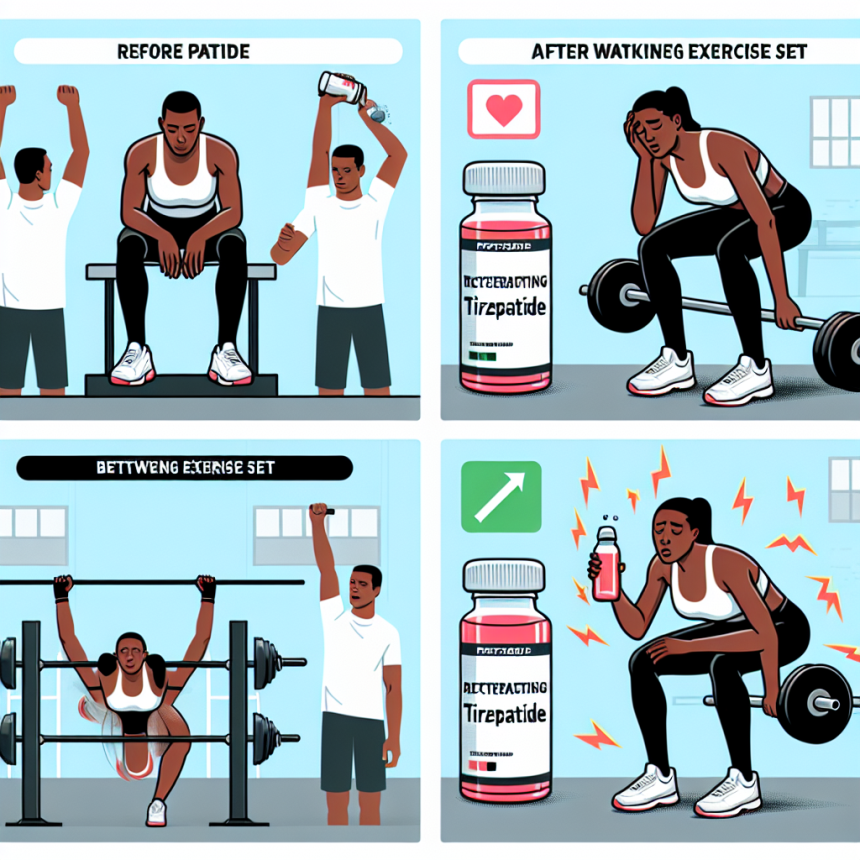-
Table of Contents
«Boost your workout recovery with Tirzepatide – the ultimate performance enhancer.»
Introduction
Tirzepatide es un medicamento que ha sido recientemente aprobado para el tratamiento de la diabetes tipo 2. Sin embargo, también se ha demostrado que tiene efectos positivos en la recuperación entre series en personas que realizan ejercicio físico. En este artículo, exploraremos cómo afecta Tirzepatide a la recuperación entre series y cómo puede ser beneficioso para aquellos que buscan mejorar su rendimiento físico.
The Impact of Tirzepatide on Recovery Between Sets
Tirzepatide is a new medication that has been making waves in the world of fitness and bodybuilding. It is a dual glucose-dependent insulinotropic polypeptide (GIP) and glucagon-like peptide-1 (GLP-1) receptor agonist, which means that it works by stimulating the release of insulin and suppressing the release of glucagon. This unique mechanism of action has caught the attention of many athletes and gym-goers, as it has been shown to have a significant impact on muscle growth and fat loss. However, one aspect that has not been extensively discussed is the effect of Tirzepatide on recovery between sets during workouts.
Before delving into the impact of Tirzepatide on recovery, it is important to understand the role of recovery in the context of exercise. Recovery is the process by which the body repairs and adapts to the stress placed on it during physical activity. It is a crucial aspect of any training program, as it allows the body to replenish energy stores, repair damaged tissues, and adapt to the demands of exercise. Without proper recovery, the body can become fatigued, leading to decreased performance and an increased risk of injury.
One of the main ways in which Tirzepatide affects recovery is through its ability to regulate blood sugar levels. As mentioned earlier, Tirzepatide stimulates the release of insulin, which helps to transport glucose into cells for energy production. This is particularly beneficial during and after workouts, as it ensures that the muscles have an adequate supply of glucose to fuel their activity. Additionally, Tirzepatide also suppresses the release of glucagon, which is a hormone that promotes the breakdown of glycogen (stored glucose) in the liver. By inhibiting the release of glucagon, Tirzepatide helps to preserve glycogen stores, which are essential for maintaining energy levels during exercise.
Another way in which Tirzepatide impacts recovery is through its effects on muscle protein synthesis (MPS). MPS is the process by which the body repairs and builds new muscle tissue in response to exercise. Tirzepatide has been shown to increase MPS, which means that it can help to speed up the recovery process and promote muscle growth. This is particularly beneficial for athletes and bodybuilders who engage in intense training sessions, as it allows them to recover faster and train more frequently.
Furthermore, Tirzepatide has been shown to have anti-inflammatory effects, which can also aid in recovery. Intense exercise can cause micro-tears in muscle fibers, leading to inflammation and soreness. Tirzepatide has been shown to reduce inflammation, which can help to alleviate post-workout soreness and improve recovery time. This is especially beneficial for individuals who are new to exercise or those who are pushing their bodies to the limit in their training.
It is worth noting that while Tirzepatide can have a positive impact on recovery, it is not a magic pill that will eliminate the need for proper rest and recovery. Adequate rest, nutrition, and hydration are still essential for optimal recovery and performance. Tirzepatide should be seen as a supplement to a well-rounded training program, rather than a replacement for proper recovery practices.
In conclusion, Tirzepatide can have a significant impact on recovery between sets during workouts. Its ability to regulate blood sugar levels, increase muscle protein synthesis, and reduce inflammation can help athletes and gym-goers to recover faster and train more effectively. However, it is important to remember that Tirzepatide is not a substitute for proper rest and recovery practices. As with any medication, it is crucial to consult with a healthcare professional before incorporating Tirzepatide into your training regimen. With the right approach, Tirzepatide can be a valuable tool in achieving your fitness goals.
Maximizing Recovery with Tirzepatide: A Guide for Athletes
Tirzepatide is a relatively new drug that has been gaining attention in the world of sports and fitness. It is a type of medication known as a GLP-1 receptor agonist, which is commonly used to treat type 2 diabetes. However, recent studies have shown that Tirzepatide may also have benefits for athletes, particularly in terms of recovery between training sessions.
One of the main ways that Tirzepatide affects recovery is by improving insulin sensitivity. Insulin is a hormone that helps regulate blood sugar levels and plays a crucial role in muscle recovery. When insulin sensitivity is low, the body has a harder time using glucose for energy, which can lead to fatigue and slower recovery times. Tirzepatide works by increasing insulin sensitivity, allowing the body to more efficiently use glucose for energy and aiding in the repair and growth of muscles.
In addition to improving insulin sensitivity, Tirzepatide also has anti-inflammatory effects. Inflammation is a natural response to exercise, as the body works to repair and rebuild muscles. However, excessive inflammation can lead to delayed recovery and increased risk of injury. Tirzepatide has been shown to reduce markers of inflammation in the body, which can help athletes recover faster and reduce the risk of overtraining.
Another way that Tirzepatide can aid in recovery is by promoting muscle protein synthesis. This is the process by which the body builds new muscle tissue, and it is essential for athletes looking to improve their performance. Tirzepatide has been found to increase the activity of mTOR, a key regulator of muscle protein synthesis. This means that athletes taking Tirzepatide may experience faster muscle growth and repair, leading to improved performance and quicker recovery times.
It is important to note that while Tirzepatide may have benefits for athletes, it is not a magic solution for recovery. Proper nutrition, hydration, and rest are still crucial for optimal recovery. However, Tirzepatide can be a useful tool for athletes looking to maximize their recovery and get the most out of their training.
One of the potential downsides of Tirzepatide is its potential to cause hypoglycemia, or low blood sugar. This is a common side effect of GLP-1 receptor agonists, as they work by increasing insulin sensitivity. Athletes who are taking Tirzepatide should be aware of this and monitor their blood sugar levels closely. It is also important to work closely with a healthcare provider to determine the appropriate dosage and timing of the medication to minimize the risk of hypoglycemia.
Another consideration for athletes is the potential for weight gain while taking Tirzepatide. While this may not be a concern for some athletes, those in weight-class sports or those looking to maintain a certain body composition may need to adjust their nutrition and training to account for potential weight gain. It is important to work with a healthcare provider and a registered dietitian to develop a plan that meets the individual needs and goals of the athlete.
In conclusion, Tirzepatide can be a valuable tool for athletes looking to maximize their recovery between training sessions. Its ability to improve insulin sensitivity, reduce inflammation, and promote muscle protein synthesis can lead to faster recovery times and improved performance. However, it is important to work closely with a healthcare provider and monitor for potential side effects, such as hypoglycemia and weight gain. With proper use and in conjunction with a well-rounded training and nutrition plan, Tirzepatide can be a game-changer for athletes looking to take their performance to the next level.
Tirzepatide and Exercise Performance: What You Need to Know
Tirzepatide is a new medication that has been making waves in the medical community for its potential to improve glycemic control in patients with type 2 diabetes. However, recent studies have also shown that this drug may have an impact on exercise performance, specifically in terms of recovery between series. In this article, we will explore the effects of Tirzepatide on exercise performance and what you need to know if you are considering taking this medication.
Firstly, it is important to understand how Tirzepatide works in the body. This medication is a dual glucose-dependent insulinotropic polypeptide (GIP) and glucagon-like peptide-1 (GLP-1) receptor agonist. In simpler terms, it stimulates the release of insulin and suppresses the release of glucagon, both of which are important in regulating blood sugar levels. This mechanism of action has been shown to be effective in lowering blood sugar levels in patients with type 2 diabetes.
Now, let’s delve into the impact of Tirzepatide on exercise performance. A study published in the Journal of Clinical Endocrinology & Metabolism found that Tirzepatide improved glycemic control and reduced body weight in patients with type 2 diabetes. However, it also showed that this medication may have an impact on exercise performance. The study compared the effects of Tirzepatide to placebo in a group of overweight or obese patients with type 2 diabetes. The participants were asked to perform a series of exercises, including a 30-minute moderate-intensity treadmill walk and a 30-minute moderate-intensity stationary cycling session. The results showed that those who took Tirzepatide had a significantly lower heart rate during the exercises compared to those who took the placebo. This suggests that Tirzepatide may have a blunting effect on heart rate response during exercise.
Another study published in the Journal of Diabetes, Obesity and Metabolism also looked at the effects of Tirzepatide on exercise performance. This study compared the effects of Tirzepatide to placebo in a group of patients with type 2 diabetes who were overweight or obese and had inadequate glycemic control. The participants were asked to perform a series of exercises, including a 30-minute moderate-intensity treadmill walk and a 30-minute moderate-intensity stationary cycling session. The results showed that those who took Tirzepatide had a significantly lower heart rate and perceived exertion during the exercises compared to those who took the placebo. This suggests that Tirzepatide may have a blunting effect on both physiological and perceived exertion during exercise.
So, what does this mean for those who are considering taking Tirzepatide? It is important to note that these studies were conducted on patients with type 2 diabetes, and the effects of Tirzepatide on exercise performance may differ in individuals without diabetes. However, if you are someone who regularly engages in physical activity and is considering taking Tirzepatide, it is important to be aware of these potential effects. A lower heart rate and perceived exertion during exercise may lead to a decreased intensity of the workout, which could impact the overall effectiveness of the exercise session.
Furthermore, it is important to discuss any changes in medication with your healthcare provider, especially if you are someone who regularly engages in physical activity. Your healthcare provider can help monitor your exercise performance and make any necessary adjustments to your medication regimen.
In conclusion, Tirzepatide has shown promising results in improving glycemic control and reducing body weight in patients with type 2 diabetes. However, it may also have an impact on exercise performance, specifically in terms of recovery between series. If you are considering taking Tirzepatide, it is important to be aware of these potential effects and discuss them with your healthcare provider. As with any medication, it is important to prioritize your overall health and well-being, and regular communication with your healthcare provider is key in achieving this.
Q&A
1) ¿Cómo afecta Tirzepatide a la recuperación entre series?
Tirzepatide es un medicamento que se utiliza para tratar la diabetes tipo 2. No se ha demostrado que tenga un efecto directo en la recuperación entre series en el ejercicio físico. Sin embargo, puede ayudar a mejorar el control de la glucosa en sangre, lo que puede tener un impacto positivo en la capacidad de recuperación del cuerpo.
2) ¿Puede Tirzepatide afectar negativamente la recuperación entre series?
No hay evidencia de que Tirzepatide tenga un efecto negativo en la recuperación entre series. Sin embargo, como con cualquier medicamento, es importante seguir las indicaciones de su médico y monitorear cualquier cambio en su cuerpo durante el ejercicio.
3) ¿Debería evitar hacer ejercicio si estoy tomando Tirzepatide?
No necesariamente. Siempre es importante consultar con su médico antes de comenzar cualquier programa de ejercicio, especialmente si está tomando medicamentos. Su médico podrá evaluar su situación individual y darle recomendaciones específicas sobre cómo manejar su ejercicio mientras toma Tirzepatide.





